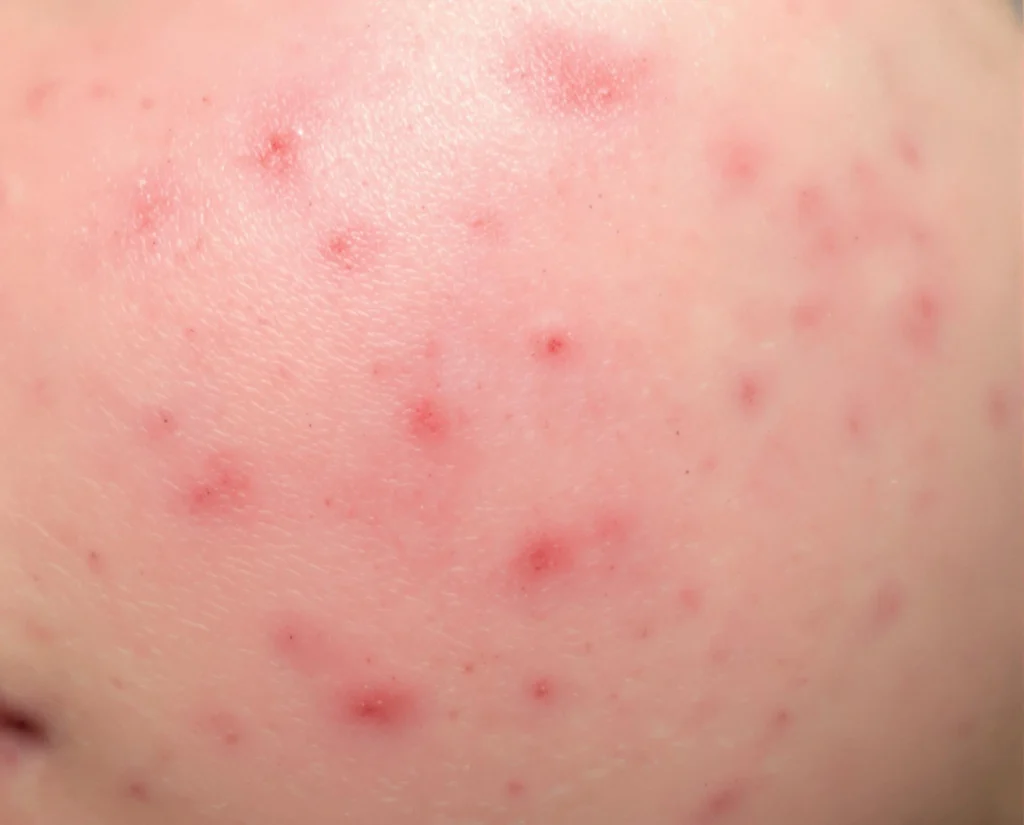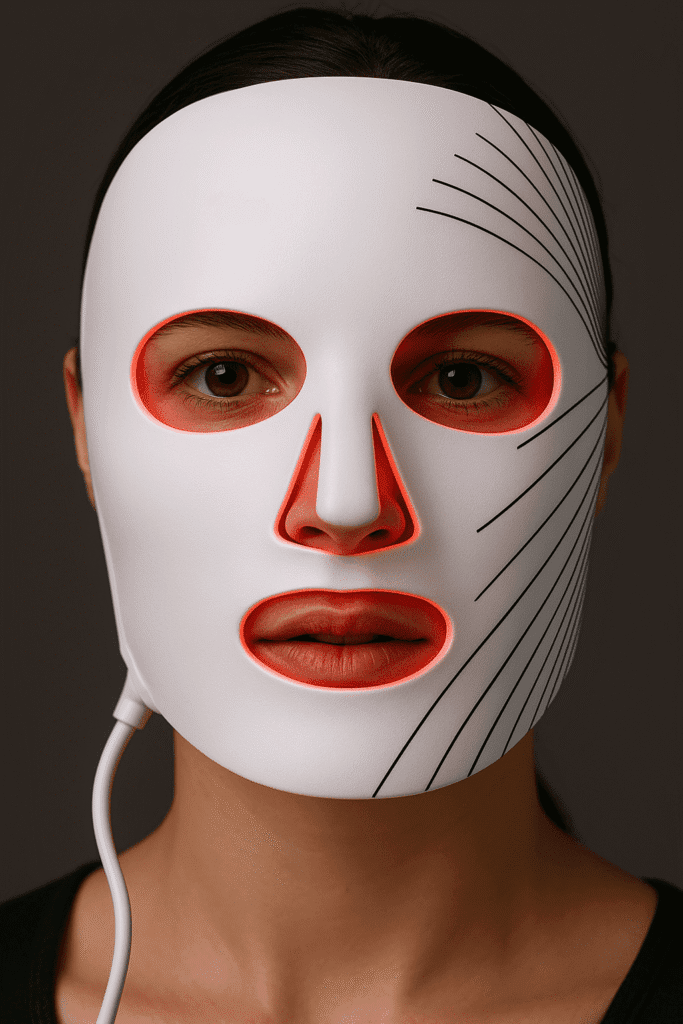Introduction to Laser Light Therapy
Acne Treatment is a hot topic amongts most teens. Creams, lotions and potions can be effective, but expensive. Laser light therapy is an advanced treatment modality that employs specific wavelengths of light to address various skin conditions, including acne. The term “laser” stands for Light Amplification by Stimulated Emission of Radiation, which signifies a technology that produces focused beams of light. When it comes to dermatological applications, different wavelengths, primarily in the red and blue spectrums, are utilized to target specific skin issues effectively.

The mechanism of laser light therapy operates on the principle of photobiomodulation. This process involves the absorption of light energy by skin tissues, leading to biochemical reactions that promote healing and regeneration. It can be a very effective acne treatment. For instance, blue light therapy specifically targets acne-causing bacteria, effectively reducing inflammation and the number of acne lesions. Conversely, red light therapy penetrates deeper into the skin layers, stimulating collagen production and enhancing overall skin texture, thereby aiding in the healing of acne scars.

Historically, laser therapies began to gain prominence in the 1960s, primarily for treating various skin disorders.
Over the decades, advancements in technology and research have refined these approaches, paving the way for precise treatments aligned with dermatological needs.
Today, laser light therapy is recognized not only for its effectiveness in acne treatment but also for its minimal invasiveness, which appeals to patients seeking alternatives to conventional treatments.
As awareness of laser light therapy grows, more individuals are turning to this innovative solution in their quest for Acne treatment and clearer complexions.
Its dual approach—targeting both the active acne and its resultant scarring—positions it as an attractive option for those grappling with persistent skin issues. By understanding the foundational principles and historical context of laser light therapy, patients can appreciate the potential this treatment holds in addressing their skin health concerns.
Understanding Acne: Causes and Types
Acne is a multifaceted skin condition that affects individuals of all ages, primarily manifesting during adolescence due to hormonal changes. However, it can persist or emerge later in life, influenced by various biological and environmental factors. At its core, acne is characterized by the clogging of hair follicles, often leading to the development of pimples, cysts, or scars, depending on its severity.
Several causes contribute to the formation of acne, including excess sebum production, bacterial growth, inflammation, and hormonal fluctuations. Androgens, a group of hormones that increase during puberty, stimulate sebaceous glands, leading to an overproduction of oil. This surplus oil can trap dead skin cells, resulting in clogged pores and providing a breeding ground for the bacteria Propionibacterium acnes, which further exacerbates inflammation.

Different types of acne present unique challenges and treatment protocols. Cystic acne is characterized by large, painful cysts that form beneath the skin, often causing significant discomfort and emotional distress.
Hormonal acne typically appears around the jawline and is attributed to fluctuations in hormone levels, commonly related to menstrual cycles or hormonal imbalances.
Inflammatory acne, on the other hand, includes red, swollen lesions that are often tender to touch and signify a response to infection or irritation within the skin.
Understanding the specific type of acne is crucial for effective treatment. For instance, hormonal acne may require a combination of lifestyle changes and medicinal interventions, while cystic acne can benefit significantly from laser light therapy, including red light therapy or other treatments aimed at reducing inflammation and promoting healing. Ultimately, a tailored approach considering the type, severity, and underlying causes of acne is essential for achieving lasting results.
The Science Behind Laser Light Therapy for Acne
Laser light therapy is an innovative approach to acne treatment, employing various wavelengths of light to penetrate the skin effectively. This therapeutic method focuses primarily on targeting the sebaceous glands and the bacteria responsible for acne development, particularly Propionibacterium acnes. Different types of laser treatments, such as red light therapy and blue light therapy, utilize specific wavelengths to achieve distinct therapeutic effects.
Red light therapy operates at a longer wavelength range, typically between 600 to 1000 nanometers. It penetrates the skin to reach deeper tissues, where it promotes circulation and stimulates cellular repair. This process reduces inflammation that is often associated with acne, thereby creating an optimal environment for healing. The increased circulation also aids in delivering essential nutrients to the skin, further enhancing its healing capabilities.
On the other hand, blue light therapy functions within a shorter wavelength range, approximately 400 to 500 nanometers. This specific wavelength is particularly effective in targeting and eliminating acne-causing bacteria. The blue light generates reactive oxygen species within the bacterial cells, leading to their destruction. By reducing the overall bacterial load on the skin, blue light therapy helps in minimizing the frequency and severity of acne breakouts.
Additionally, laser light therapy contributes to the reduction of sebum production by acting on the sebaceous glands. By regulating oil production, the therapy reduces the chances of pores becoming clogged, which is a primary contributor to acne formation. Through consistent application of these laser treatments, patients may observe not only a decrease in existing acne lesions but also a significant reduction in future breakouts.
Overall, the combination of anti-inflammatory properties, bacterial reduction, and sebum regulation signifies that laser light therapy is a multifaceted approach to acne management, offering a scientific basis for its efficacy in treating this common skin condition.
Effective Laser Spectrums for Acne Treatment
Laser light therapy has emerged as a prominent treatment modality for various types of acne, leveraging different spectrums of light to target the underlying causes of skin inflammation and breakouts. Among these treatments, blue light therapy is particularly noteworthy. Blue light operates at a specific wavelength that is effective in eliminating acne-causing bacteria, notably Propionibacterium acnes, by producing reactive oxygen species that are toxic to these pathogens. Clinical studies have shown that patients undergoing blue light therapy often experience a significant reduction in inflammatory lesions and improved overall skin appearance.
Red light therapy also plays a vital role in the management of acne. Unlike blue light, which targets bacteria directly, red light works by penetrating deeper into the skin’s layers. It promotes healing by stimulating cellular repair and reducing inflammation. This spectrum of light is beneficial for individuals suffering from post-inflammatory hyperpigmentation, as it can improve skin texture and encourage collagen production. Several clinical trials have indicated that red light therapy can pave the way for accelerated healing processes, often resulting in marked improvements in skin condition.
Infrared light therapy complements the effects of blue and red light by enhancing overall skin health. Though it is less commonly used solely for acne treatment, its benefits in promoting circulation and reducing scar formation make it a useful adjunctive treatment. Infrared therapy operates beneath the skin’s surface, promoting deeper tissue repair and regeneration. Emerging evidence suggests that incorporating infrared light into acne treatment regimens can yield beneficial results, particularly for individuals with persistent or cystic acne.
In conclusion, the combination of blue, red, and infrared light therapies offers a multi-faceted approach to acne treatment, each spectrum contributing to the overall effectiveness by addressing different aspects of acne pathology. As further research unfolds, the integration of these laser light therapies continues to provide new avenues for achieving clearer, healthier skin.
Comparing Laser Light Therapy to Traditional Acne Treatments
When addressing acne management, a multitude of treatment options are available, including laser light therapy and traditional methodologies such as topical medications, oral antibiotics, and chemical peels. Each approach possesses unique benefits and drawbacks, making it essential to evaluate them based on efficacy, side effects, and individual patient needs.
Topical medications, which may include retinoids and benzoyl peroxide, are commonly prescribed as first-line treatments for acne. They are accessible and typically have fewer systemic side effects, yet their effectiveness can vary. Some patients may experience irritation or dryness, and results can take weeks to manifest. In contrast, oral antibiotics, such as tetracyclines, have demonstrated considerable success in reducing inflammation and bacteria. However, their prolonged use can lead to resistance and potential complications, including gastrointestinal disturbances.
On the other hand, laser light therapy offers a distinct mechanism of action through light wavelengths—red light therapy aims to reduce inflammation, while blue light therapy targets acne-causing bacteria. The efficacy of laser treatments can be compelling; many patients experience marked improvement after a series of sessions. Moreover, laser treatments are less likely to result in post-inflammatory hyperpigmentation compared to traditional methods. However, some individuals may find laser light therapy cost-prohibitive, and potential side effects like transient redness or swelling can occur.
In weighing the pros and cons, patient preference plays a crucial role. While some may favor the targeted, intensive approach of laser light therapy, others might prefer the more familiar, conventional treatments. Individualized treatment plans can harmonize these preferences with medical necessity, thereby tailoring the acne treatment experience to each patient’s unique situation. The choice between laser light therapy and traditional treatments should be informed by a comprehensive understanding of these factors, ensuring that each patient achieves the best possible outcome for their acne condition.
What to Expect During a Laser Treatment Session
When considering laser light therapy for acne treatment, it is essential to understand the patient experience associated with the procedure. The first step involves a thorough consultation with a qualified dermatologist, who will evaluate the type and severity of the acne and discuss appropriate laser modalities, such as red light therapy or blue light therapy. This preparatory stage may include skincare recommendations to optimize results.
On the day of the treatment, patients are usually advised to cleanse their skin and avoid applying any products that may cause irritation. During the session, which typically lasts between 20 to 45 minutes depending on the areas being treated, patients can expect to wear protective eyewear. The clinician will apply a cooling gel to the skin to minimize discomfort. As the laser is activated, pulses of light will be directed toward the acne-affected areas. Most individuals report minimal pain, often described as a mild tingling sensation, especially when using blue light therapy, which targets bacteria effectively.
Post-treatment care is crucial; patients may experience mild redness or swelling, akin to a sunburn, which usually subsides within a few hours. A gentle skincare regimen is recommended during the healing process, alongside the use of sunscreen to protect the treated skin. Patients can typically resume their normal activities immediately, although some may need to avoid strenuous exercises for a day or two.
For optimal results, multiple sessions may be necessary, typically spaced a few weeks apart. The total number of sessions will depend on individual factors, including acne severity and response to treatment.Clinicians often create personalized treatment plans to ensure that the advantages of both red light therapy and other laser modalities are fully utilized in reducing acne and preventing future outbreaks.
Potential Side Effects and Risks of Laser Light Therapy
Laser light therapy is increasingly recognized as an effective treatment for acne. However, like any medical procedure, it is accompanied by potential side effects and risks that patients should be aware of. Understanding these concerns is crucial to making informed decisions regarding treatment options. Some of the most commonly reported side effects include skin irritation, photosensitivity, and hyperpigmentation. Skin irritation may manifest as redness, swelling, or discomfort immediately following treatment. This is often temporary, but it is important for patients to manage their skin sensitivity carefully post-procedure.
Photosensitivity is another significant concern associated with laser light therapy. Patients undergoing treatments involving red light therapy or blue light therapy may experience increased sensitivity to sunlight, which could lead to sunburn or exacerbation of existing skin conditions. It is advisable for patients to employ protective measures, such as using broad-spectrum sunscreen and wearing protective clothing, following their treatments to mitigate these risks.
Moreover, hyperpigmentation is a potential risk, particularly in individuals with darker skin tones. This condition arises when laser treatments stimulate an excess of melanin production, leading to dark spots on the skin. To minimize such risks, it is essential for patients to seek consultations with qualified dermatologists who can tailor treatments to individual skin types and conditions. A professional specialist will conduct a thorough assessment, ensuring that the selected laser light therapy method—whether it be red light therapy or alternatives—aligns with the patient’s specific needs.
In conclusion, while laser light therapy can offer significant benefits for acne treatment, it is paramount to remain informed about its potential side effects and risks. Adequate precautions, tailored treatment plans, and expert guidance can enhance the safety and efficacy of these therapies, leading to better outcomes for patients.
Long-Term Benefits and Maintenance of Results
Laser light therapy has emerged as a promising method for treating acne, offering not only immediate improvements but also promising long-term benefits. One key advantage of these therapies, including red light therapy and blue light therapy, is their ability to reduce inflammation and target the bacteria associated with acne. Upon receiving treatment, many patients experience a significant decrease in the frequency and severity of acne breakouts. These effects can persist for months or even years following a treatment regimen, leading to sustained improvements in skin condition.
To maintain the results achieved through laser light therapy, it is essential to incorporate a comprehensive skincare routine tailored to individual skin types. This routine should include gentle cleansers, non-comedogenic moisturizers, and sunscreens with adequate SPF protection. Daily application of topical treatments containing active ingredients, such as salicylic acid or retinoids, can further enhance the effects of previous treatments and help prevent future breakouts. Regular consultations with a dermatologist can also assist in personalizing these routines and addressing any emerging skin concerns.

Lifestyle changes contribute significantly to the efficacy of long-term acne treatment. Maintaining a balanced diet rich in antioxidants, staying well-hydrated, and managing stress through exercise or relaxation techniques can all play a role in promoting clear skin. Furthermore, avoiding known skin irritants and maintaining proper hygiene can prevent the resurgence of acne. In some cases, periodic follow-up treatments may be beneficial; these may include additional sessions of blue light therapy or maintenance treatments to boost and prolong results. Patient success stories often reflect the positive outcomes of these combined strategies, illustrating the importance of commitment to long-term skincare and treatment plans.
In conclusion, harnessing the benefits of laser light therapy extends beyond the treatment chair. By adopting a consistent skincare routine, making healthy lifestyle choices, and considering supplementary treatments, individuals can enjoy lasting results in their journey towards clear skin.
Conclusion and Final Thoughts
Throughout this comprehensive guide, we have explored the various modalities of laser light therapy, including red light therapy and blue light therapy, and their effectiveness in treating acne. Understanding how these therapies work is crucial for anyone looking to enhance their skincare routine. By targeting the underlying causes of acne, these therapies can reduce inflammation, kill acne-causing bacteria, and promote tissue repair. It is essential to recognize that laser light therapy is not a one-size-fits-all solution; individual responses may vary based on skin type, severity of acne, and other factors.
The potential benefits of laser light therapy for treatment are numerous. Not only can it clear existing breakouts, but it can also help prevent future outbreaks. Red light therapy, for instance, is known for its anti-inflammatory properties, while blue light therapy is effective in targeting bacteria on the skin. Understanding these distinct advantages allows individuals to make informed decisions regarding their treatment options.
While the effectiveness of laser light therapy has been well-documented, it is imperative to consider a professional consultation to develop a personalized treatment plan. A qualified dermatologist can assess individual conditions, recommend the appropriate type of laser therapy, and establish a comprehensive strategy that may include other skincare practices. This coordinated approach is vital for achieving optimal results and maintaining healthy skin in the long run.
In light of the information presented, it is evident that laser light therapy holds significant promise as an innovative treatment for acne. As we advance in our understanding of skincare technology and therapeutic options, incorporating such sophisticated treatments could very well transform the way we approach acne and skin health. Ultimately, by recognizing the importance of tailored treatments, individuals have the potential to achieve clearer, healthier skin.
Related Article Best Red Light Therapy Options for Acne




